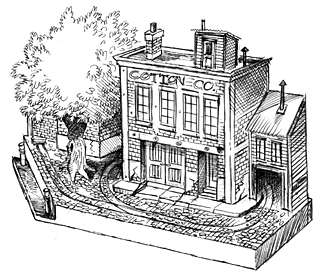| To date, I have received five designs
in response to the parameters set on The Next Layout page. All designers are members of the Yahoo! Small Layout Design group.
The designs and suggestions have come from (click on their name to go to their ideas): Jack Trollope, Donald Kinney, Art Papaynanopulos, Jon Song°ygard, & Larry Smith The first response came from Jack (Shortliner) Trollope, who said this:
And here are pictures of the Savannah Waterfront and John Stuart Mill layouts that Jack proposed that I modify to work:
The second came from Donald Kinney, who said this:
And here is his layout drawing: Unfortunately, I've managed to lose the file for this drawing...
The third design came from Art Papaynanopulos, who said:
And here is his layout drawing:
Both of these designs meet the four square foot constraint. I corresponded to Art about the standard gauge track and suggested that the barrel factory, and the standard gauge service track to it, be rotated 90 degrees counterclockwise. Then the standard gauge track could be extended to curve around parallel with the right edge of the layout and join the narrow gauge loop, forming a dual gauge track into the tunnel, where the barrel car could be hidden.
After quite some time without any further suggestions, I received this design from Jon Song°ygard. His description is as follows:
Here's my proposal for your next layout. I admit I've borrowed some
items from the previous contributors, but at one point I've made a
strict change: The two gauges no longer meet at the factory corner.
Here, the narrow gauge line has to serve the factory while the barrel
car is gone, and vice versa.
The concept is quite similar to that of Art Papaynanopulos (whose
solution is indeed innovative), but I've left out the logging camp.
However, lumber cars may be loaded inside the tunnel, if you make an
opening at back (also convenient for "fiddling" and rerailing
cars...).
The Barrel Factory (and barrel car) is placed at
the centre part of the layout, where it will get the main focus and can
be fully admired by the audience and owner. Space for a sawmill has
also good visibility, near the layout edge.
I'd suggest modeling a heavy forest scene at the
right-hand hill, to disguise the fact that it has no other scenic
features. Leaving the hill rather unconspicuous will also help draw away
the viewers' attention while you're hiding the barrel car in the tunnel.
Tracks are quite crammed, in an attempt to disguise
the rather sharp curves and the track oval (which also serves as a
runaround track!). The "diamond" should also be a scenic
attention-getter.
It's possible to build a track (dotted line)
between the top of the oval and the extension to Monte Sano RR, or you
can simply put a scenic item here. In addition, I guess there's space
for another track or two near the sawmill.
When the barrel car is loaded at the factory track,
cars from the sawmill will have to be spotted at the track lowest on the
layout plan.
For realistic unloading of cars at the factory (and
loading/unloading at the sawmill), I'd suggest a functioning crane near
the end of the factory, to perform this hard labor (hence the factory
track is stretched beyond the building). The sawmill will need another
crane, or another solution.
If you handle loads this way, you'll have to return
them to their starting points between operations.
And here is his layout drawing:
12/16/03, A Suggestion from Larry Smith of Pelham, Alabama Suggestions: The loading track in front of the Barrel Company should be dual gauged as this is where the barrels are shipped from and the lumber received from. I would include the sawmill that Sam Swanson is building in Model Railroading as the source for your lumber. It is a water powered sawmill and the logs are received by truck, or flat car dumped down and embankment and stored in the dammed up creek. It is small enough that it would fit in the space requirements that you have and still be big enough to supply the barrel works. I too will have a stave and barrel mill on my new layout, I'm working on mini modules that will go onto a 30" x 60" module, but the space and the building will take up what you have proposed for your entire layout. It will share the same module as my main sawmill. The track plan as I see it is a simple C with the dual gauge running across the front to serve the barrel company. The narrow gauge would go around to the back where the sawmill is located. If you want more fun, you can add a kindling wood plant along side the barrel factory and run a siding into it. Take a look at narrowtracks.com then go to the Eastern loggers section of the site and take a look at their sawmill complex. It will give you some major ideas on how to place things. Larry Smith |


